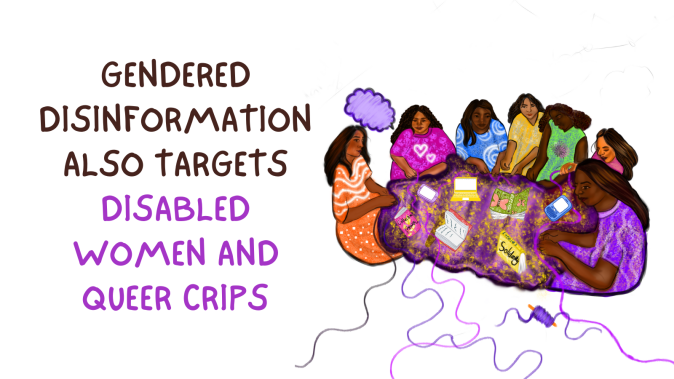Gendered Disinformation Targets Disabled Women and Queer Crips: #DefeatDeceit

Online gender-based violence, including gendered disinformation, uses gender as the main axis for their attacks against a target (or targets). But it’s not the only identity they use. Attackers often also use various other marginalised identities their target(s) may have in their attacks to demean and invalidate women and queer persons.
One of these identities is disability. Although disability-related attacks are also used against non-disabled women, it is done in a way that shows disability as undesirable and a legitimate mode of dismissal.
So when it comes to disabled women and queer crips, these attacks have exponentially more venom.
A quick introduction to gendered disinformation: “Gendered disinformation is a strategy to silence women and queer folks that “uses false or misleading gender and sex-based narratives against women, often with some degree of coordination”, and aims to stop women and queer (human rights defenders) from taking part in digital publics.
Not only does it combine falsity, coordination and malign intent — the three defining characteristics of disinformation — it is gendered because:
- It targets women and gender-diverse folks.
- It uses gendered stereotypes and beliefs in its attacks.
- It reinforces prejudices and barriers against gender justice.”[1]
And we know that gender and disability already intersect in the lives of disabled women and queers in various ways, such as when a disabled woman is thought to be not “woman enough” because she cannot take care of her family in exactly the same ways that a non-disabled woman is able to, or when disabled queers are distanced from their sexualities and invisibilised in the community.
These existing social norms are leveraged by attackers online against disabled women and queer persons when they use disability and gender stereotypes and prejudices to influence public opinions about people and communities. These biases are used to discredit disabled women and queer persons, as gendered disinformation aims to, and affect the well-being of people it is targeting.
The result? It chills the participation of disabled women and queer persons in digital publics — voices that are doubly necessary for the healthy functioning of democratic societies as they come from positions that give us more overview into what’s going wrong and how we can do better to include and move forward existing policies, as well as norms.
Apart from the shape that gendered disinformation takes when interlaced with ableism is the question of access itself as it is (or as it is not) encoded into technology platforms that we use. This makes it harder for disabled women and queer persons to even enter popular Big Tech platforms.
As mentioned earlier in the series, “Accessibility in general is hard to come by for disabled persons, be it online or offline. In the digital world, just as in the physical world, access is rarely an in-built feature. It is mostly an afterthought, and a hard-won one at that. Since most platforms aren’t accessible to most disabled persons, the entry of disabled women is either not possible in many or their interactions with the digital environment are forced to remain on the surface-level.
What happens in such a situation is: Disabled women or women human rights defenders may not even be aware of the digital violence carried out against them, and are forced to know about it from other sources — when it has already been disseminated to such a level. This is a layer of ableist violence coded into most technology that disallows women with disabilities to know it first hand, report it, respond to it or halt it in other ways.”[2]
So the question of access should be one of our focal issues, even when we talk about online violence that leverages disability in other ways — as inaccessibility is violence in and of itself, on a much more basic level.
We know that a feminist internet is free of, or at least has effective ways to counteract, all forms of online violence — including ableist gendered disinformation. But what can we do now?
While we aim for more long-term policies and solutions against this problem, we can pledge to not be a digital bystander. We can actively engage and take a stand against ableist gendered disinformation when we see it, in a variety of ways.
We can ask technology platforms more more disability access, show online support and solidarity with the target(s) of attacks, use reporting mechanisms (even though the response to many valid issues is quite low, and that’s another issue), offer support wherever and however we can, amplify the voices of survivors and activists, and share resources with the people around us — and educate ourselves as well as our circles.
Negative narratives about disabled women and queer persons helps in legitimising technology-facilitated and physical violence against them. Ask for more accessibility and better information accountability from key internet stakeholders, such as Big Tech platforms, political and community leaders, and digital influencers.
And although algorithms and the design of Big Tech platforms support the spread of misinformation and disinformation going viral, these actions can help us extend community care online.
Image by Imaan Jufeer
[1] https://takebackthetech.net/index.php/blog/gendered-disinformation-101-when-gender-locus-defeatdeceit
[2] Link to the earlier disabled women blog
- Log in to post comments
